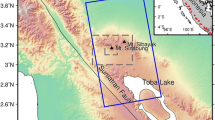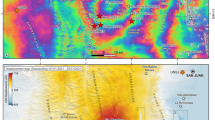Abstract
We analyze digital topographic data collected in September 1993 over a ∼500-km2 portion of K*lauea Volcano, Hawai'i, by the C-band (5.6-cm wavelength) topographic synthetic aperture radar (TOPSAR) airborne interferometric radar. Field surveys covering an ∼1-km2 area of the summit caldera and the distal end of an ∼8-m-thick 'a'* flow indicate that the 10-m spatial resolution TOPSAR data have a vertical accuracy of 1–2 m over a variety of volcanic surfaces. After conversion to a common datum, TOPSAR data agree favorably with a digital elevation model (DEM) produced by the U.S. Geological Survey (USGS), with the important exception of the region of the ongoing eruption (which postdates the USGS DEM). This DEM comparison gives us confidence that subtracting the USGS data from TOPSAR data will produce a reasonable estimate of the erupted volume as of September 1993. This subtraction produces dense rock equivalent (DRE) volumes of 392, 439, and 90×106 m3 for the Pu'u '*'*, K*pa'ianah*, and episode 50–53 stages of the eruption, respectively. These are 124, 89, and 94% of the volumes calculated by staff of the Hawaiian Volcano Observatory (HVO) but do not include lava of K*pa'ianah* and episodes 50–53 that flowed into the ocean and are thus invisible to TOPSAR. Accounting for this lava increases the TOPSAR volumes to 124, 159, and 129% of the HVO volumes. Including the ±2-m uncertainty derived from the field surveys produces TOPSAR-derived volumes for the eruption as a whole that range between 81 and 125% of the USGS-derived values. The vesicularity- and ocean-corrected TOPSAR volumes yield volumetric eruption rates of 4.5, 4.5, and 2.7 m3/s for the three stages of the eruption, which compare with HVO-derived values of 3.6, 2.8, and 2.1 m3/s, respectively. Our analysis shows that care must be taken when vertically registering the TOPSAR and USGS DEMs to a common datum because C-band TOPSAR penetrates only partially into thick forest and therefore produces a DEM within the tree canopy, whereas the USGS DEM is adjusted for vegetation.
Similar content being viewed by others
Author information
Authors and Affiliations
Additional information
Received: 28 April 1998 / Accepted: 1 February 1999
Rights and permissions
About this article
Cite this article
Rowland, S., MacKay, M., Garbeil, H. et al. Topographic analyses of K*lauea Volcano, Hawai'i, from interferometric airborne radar. Bull Volcanol 61, 1–14 (1999). https://doi.org/10.1007/s004450050258
Issue Date:
DOI: https://doi.org/10.1007/s004450050258




